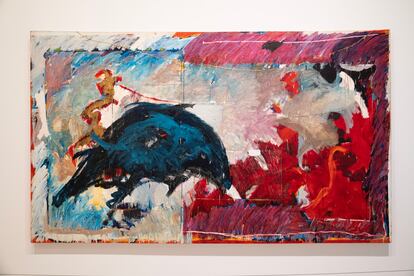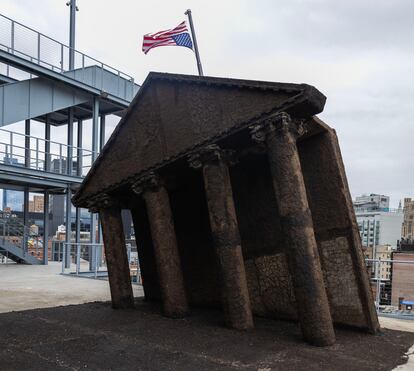It is no accident that all biennials happily resemble each other, but each one is unhappy in its own way. To the calamity of the last great biennial, that of Venice, is now added the oldest in America, that of the Whitney, created in 1932. It is true that, to the world of art and culture in general, there is still much left to say about what it means to live with differences, fluid identities, the urgency of recovering the natural environment and also doing so with political radicalism. It has always been this way and it is not something isolated or specific to a specific society. In the mid-19th century, the small public that came to a museum looked with greater or lesser zeal for a social detail in a painting while being able to value the artist’s ability to reproduce the dazzling reflection of light. Today we travel en masse to cultural capitals with the same aesthetic purpose. We have naturalized the demand for the visibility of women and greater diversity in museum offices, in collections and large artistic events.
In 1993, the Whitney Biennial was the first to showcase the work of white Western artists in a minority versus that of women, African Americans, and LGTBIQ identities. The context of that meeting of American contemporary art was that of events that still shock us and say a lot about the limits of nostalgia. Bill Clinton had just begun his mandate in the midst of the trauma of AIDS and the first terrorist attack on the World Trade Center came to the news the very week of the inauguration of that biennial, which brought together the then young Nan Goldin, Kiki Smith, Janine Antoni, Glenn Ligon, Coco Fusco, Trinh T. Minh-ha, Gary Simmons, Sue Williams, Lorna Simpson or Renée Green.
His works, in file format, video installation, film, photography, painting or performance, had a great impact on the way we interpreted reality, with a mass Internet in the making and an AI only imaginable on the big screen. He then began to talk about a “museum cinema.” Now cinema fits in a pocket and the rehabilitation of women and cultural minorities has the category of masterpiece, at least institutionally. But, as the motto of the 81st Whitney Biennial prefigures, Even Better Than The Real Thing (or “even better than real”) we continue to demand passionate searchers who want to go beyond what we understand by “real.”
The title of the biennial, taken from a U2 song, is an indicator of the bucolic promise of a new world (and perhaps a tactic against contemporary anxiety). The curators, Chrissie Iles (74 years old) and Meg Onli (40 years old), agree that the works of the 72 selected artists and groups are a “dissonant chorus” and that this fits inadequately in a brand new museum-megaphone of million-dollar companies ( with Tiffany and Bulgari as main sponsors).

The sovereignty of bodies, the fluidity of gender, the representation of indigenous cultures and the care of the natural world are essential axes for life, which in this biennial are exhibited as a rough visual formalization of American art made by emerging authors, although For some time now, this New York institution has expanded the definition of what American art is and incorporates established authors from all over the world.
Distributed between two floors of the museum, the works are based mainly on the social conquests of the past to vindicate other forms of authentic existence and sexuality, based on intimate enjoyment. Break the cage that we all have inside and make it an ethic, a style, even if that means becoming institutionalized. The last romantic sigh. The works that exhibit greater formal temper are also those with the greatest transformative impact by already established artists, or are interpretations of those political sexual struggles that began with the countercultural movements of half a century ago. One case is that of a striker of trans activism like Marsha P. Johnson (1945-1992), present in two current works: the video Pollinatorby the transgender activist Tourmaline, and in the installation that Kiyan Williams has taken to one of the museum’s terraces, where a sculpture with Johnson’s image observes the ruins of the White House façade (The Earth Swallows the Master’s House).

Lacunae, by Mary Kelly, is a poetic self-portrait of parchment and ashes placed on the wall as an almanac, which speaks of the aging and death of loved ones.
In Ricerche: fourSharon Hayes films three groups of LGTBQIA seniors reflecting on their loves and identities and what it means to come together in a post-pandemic time, in a nod to Pasolini’s film Survey of Love, a Social Portrait of Changing Values of sexuality in post-war Italy. Once Again. . . (Statues Never Die), by Isaac Julien, is a video installation composed of five screens, pieces of African art and sculptures by Richmond Barthé about the figure of the philosopher and educator Alain Locke (1885-1954), who urged members of the African diaspora to celebrate his art as claim their cultural heritage.
Julien’s dreamlike recreation of his figure is part of a recurring question in museums that have begun the process of decolonizing their collections. Who has the authority to speak? Who defines black modernism, or any culture? How to negotiate queer power and desire? Some answers are in another corner of the city, in the Metropolitan Museum, which opportunely dedicates an exhibition to the Harlem Renaissance movement, which had Locke as a seminal figure. Beyond any happy biennial, the art of the last century continues to have its cultural uses.
‘Even Better Than The Real Thing’. Whitney Biennial. Whitney Museum. NY. Until August 11.
You can follow Babelia in Facebook and xor sign up here to receive our weekly newsletter.
Subscribe to continue reading
Read without limits
_
#Whitney #Biennial #Arts #Rough #Reflection #Latest #Social #Change